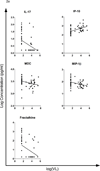The effect of HIV infection and HAART on inflammatory biomarkers in a population-based cohort of women
- PMID: 21572306
- PMCID: PMC3314300
- DOI: 10.1097/QAD.0b013e3283489d1f
The effect of HIV infection and HAART on inflammatory biomarkers in a population-based cohort of women
Abstract
Objective: HIV causes inflammation that can be at least partially corrected by HAART. To determine the qualitative and quantitative nature of cytokine perturbation, we compared cytokine patterns in three HIV clinical groups, including HAART responders (HAART), untreated HIV noncontrollers, and HIV-uninfected (NEG).
Methods: Multiplex assays were used to measure 32 cytokines in a cross-sectional study of participants in the Women's Interagency HIV Study. Participants from three groups were included: HAART (n = 17), noncontrollers (n = 14), and HIV NEG (n = 17).
Results: Several cytokines and chemokines showed significant differences between noncontrollers and NEG participants, including elevated interferon gamma-induced 10 (IP-10) and tumor necrosis factor-α (TNF-α) and decreased interleukin-12(p40) [IL-12(p40)], IL-15, and fibroblast growth factor-2 (FGF-2) in noncontroller participants. Biomarker levels among HAART women more closely resembled the NEG, with the exception of TNF-α and FGF-2. Secondary analyses of the combined HAART and noncontroller groups revealed that IP-10 showed a strong, positive correlation with viral load and negative correlation with CD4(+) T-cell counts. The growth factors vascular endothelial growth factor, epidermal growth factor, and FGF-2 all showed a positive correlation with increased CD4(+) T-cell counts.
Conclusion: Untreated, progressive HIV infection was associated with decreased serum levels of cytokines important in T-cell homeostasis (IL-15) and T-cell phenotype determination (IL-12), and increased levels of innate inflammatory mediators such as IP-10 and TNF-α. HAART was associated with cytokine profiles that more closely resembled those of HIV-uninfected women. The distinctive pattern of cytokine levels in the three study groups may provide insights into HIV pathogenesis, and responses to therapy.
Figures



Comment in
-
Old and new plasma biomarkers in HIV-1-infected African-American women.AIDS. 2011 Sep 24;25(15):1921-3. doi: 10.1097/QAD.0b013e32834a1e77. AIDS. 2011. PMID: 21914979 No abstract available.
Similar articles
-
The effect of a year of highly active antiretroviral therapy on immune reconstruction and cytokines in HIV/AIDS patients.AIDS Res Hum Retroviruses. 2013 Apr;29(4):691-7. doi: 10.1089/aid.2012.0275. Epub 2013 Jan 18. AIDS Res Hum Retroviruses. 2013. PMID: 23151174
-
The effect of HAART-induced HIV suppression on circulating markers of inflammation and immune activation.AIDS. 2015 Feb 20;29(4):463-71. doi: 10.1097/QAD.0000000000000545. AIDS. 2015. PMID: 25630041 Free PMC article.
-
IMMUNOLOGICAL PROFILES IN HIV POSITIVE PATIENTS FOLLOWING HAART INITIATION IN KIGALI, RWANDA.East Afr Med J. 2014 Aug;91(8):261-6. East Afr Med J. 2014. PMID: 26862650
-
Dysregulated Immune Activation in Second-Line HAART HIV+ Patients Is Similar to That of Untreated Patients.PLoS One. 2015 Dec 18;10(12):e0145261. doi: 10.1371/journal.pone.0145261. eCollection 2015. PLoS One. 2015. PMID: 26684789 Free PMC article.
-
Thymic function in HIV-infection.Dan Med J. 2013 Apr;60(4):B4622. Dan Med J. 2013. PMID: 23651726 Review.
Cited by
-
FGF/FGFR signaling in health and disease.Signal Transduct Target Ther. 2020 Sep 2;5(1):181. doi: 10.1038/s41392-020-00222-7. Signal Transduct Target Ther. 2020. PMID: 32879300 Free PMC article. Review.
-
Study design issues in evaluating immune biomarkers.Curr Opin HIV AIDS. 2013 Mar;8(2):147-54. doi: 10.1097/COH.0b013e32835d3259. Curr Opin HIV AIDS. 2013. PMID: 23380656 Free PMC article. Review.
-
Exploring the Structural and Functional Diversity among FGF Signals: A Comparative Study of Human, Mouse, and Xenopus FGF Ligands in Embryonic Development and Cancer Pathogenesis.Int J Mol Sci. 2023 Apr 20;24(8):7556. doi: 10.3390/ijms24087556. Int J Mol Sci. 2023. PMID: 37108717 Free PMC article. Review.
-
Low antigen-specific CD4 T-cell immune responses despite normal absolute CD4 counts after long-term antiretroviral therapy an African cohort.Immunol Lett. 2014 Dec;162(2 Pt B):264-72. doi: 10.1016/j.imlet.2014.09.016. Epub 2014 Sep 26. Immunol Lett. 2014. PMID: 25263953 Free PMC article. Clinical Trial.
-
Systemic Inflammation, Coagulation, and Clinical Risk in the START Trial.Open Forum Infect Dis. 2017 Nov 28;4(4):ofx262. doi: 10.1093/ofid/ofx262. eCollection 2017 Fall. Open Forum Infect Dis. 2017. PMID: 29308409 Free PMC article.
References
-
- Brettle RP, McNeil AJ, Burns S, Gore SM, Bird AG, Yap PL, et al. Progression of HIV: follow-up of Edinburgh injecting drug users with narrow seroconversion intervals in 1983–1985. Aids. 1996;10:419–430. - PubMed
-
- Mellors JW, Rinaldo CR, Jr, Gupta P, White RM, Todd JA, Kingsley LA. Prognosis in HIV-1 infection predicted by the quantity of virus in plasma [see comments] [published erratum appears in Science 1997 Jan 3;275(52960):14] Science. 1996;272:1167–1170. - PubMed
-
- Liu Z, Cumberland WG, Hultin LE, Prince HE, Detels R, Giorgi JV. Elevated CD38 antigen expression on CD8+ T cells is a stronger marker for the risk of chronic HIV disease progression to AIDS and death in the Multicenter AIDS Cohort Study than CD4+ cell count, soluble immune activation markers, or combinations of HLA-DR and CD38 expression. J Acquir Immune Defic Syndr Hum Retrovirol. 1997;16:83–92. - PubMed
Publication types
MeSH terms
Substances
Grants and funding
- UO1-HD-32632/HD/NICHD NIH HHS/United States
- U01 DK066116/DK/NIDDK NIH HHS/United States
- UO1-AI-34994/AI/NIAID NIH HHS/United States
- UO1-AI-34989/AI/NIAID NIH HHS/United States
- U01 AI031834/AI/NIAID NIH HHS/United States
- U01 AI035004/AI/NIAID NIH HHS/United States
- UO1-AI-35004/AI/NIAID NIH HHS/United States
- UO1-AI-34993/AI/NIAID NIH HHS/United States
- U01 AI034994/AI/NIAID NIH HHS/United States
- P30 AI027763/AI/NIAID NIH HHS/United States
- UO1-AI-42590/AI/NIAID NIH HHS/United States
- U01 AI034993/AI/NIAID NIH HHS/United States
- UO1-AI-31834/AI/NIAID NIH HHS/United States
- UL1 RR024131/RR/NCRR NIH HHS/United States
- U01 AI034989/AI/NIAID NIH HHS/United States
- U01 HD032632/HD/NICHD NIH HHS/United States
- U01 AI042590/AI/NIAID NIH HHS/United States
LinkOut - more resources
Full Text Sources
Other Literature Sources
Medical
Research Materials

